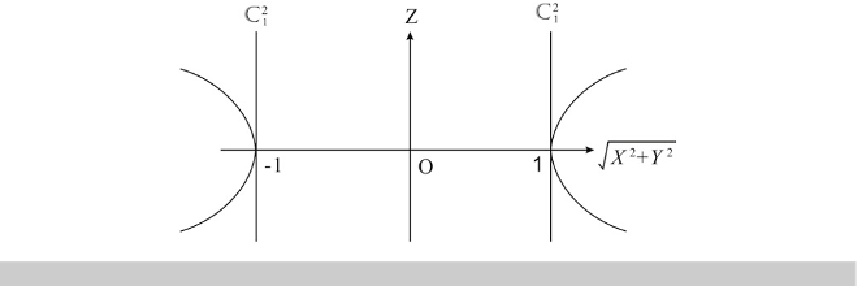Geography Reference
In-Depth Information
M
2
of type hyperboloid
H
2
,
vertical section
, projective design
Fig. 23.10.
Two-dimensional Riemann manifold
C
1
of radius one (normal placement)
of the
circular cylinder
We are left with the problem
to determine the unknown functions f(V).
Here again we follow the
constructive approach
of the
theory of map projections
in case the structure of map (
23.15
) is given.
Its generic steps are outlined in Box
23.9
:The
first generic step
is based upon the “
left Jacobi map
”
being represented by the matrix (
23.16b
)of
first derivatives
subject to the
condition
(
23.17a
)
which preserves the orientation of the differential map (
dx, dy
)
(
dU, dV
) also called “pull-
back”. The representation of the “
left Cauchy-Green deformation tensor
”
C
l
:=
J
l
G
r
J
l
subject
to the “
right metric tensor
”
G
r
=
I
2
(unit matrix) of the
developed
circular cylinder is the target
of the
second generic step
(
23.17b
). The
third generic step
leads us to a comparison of the “
left
metric tensor
”
G
l
of the hyperboloid
H
→
2
with the “
left Cauchy-Green deformation tensor
”
C
l
,
namely by a simultaneous diagonalization of the pair of positive definite matrices
{C
l
,G
l
}
which
leads to the
general eigenvalue problem
(
23.18
) with respect to the matrices
C
l
given by (
23.17c
)
and
G
l
given by (
23.19
). As a result the
eigenvalues
of type (
23.21
) are computed by
means of solving the
characteristic equation
(
23.20
). The
fourth step
leads us to the postulates of
(
α
) a conformal mapping (conformeomorphism): Box
23.10
Λ
1
=
Λ
2
,
(
β
) an equiareal mapping (areomorphism): Box
23.12
Λ
1
Λ
2
=1
,
(
γ
) an equidistant mapping: Box
23.14
Λ
2
=1.
For the
case
(
α
)ofa
conformal mapping
the “
canonical postulate
”
Λ
1
=
Λ
2
, the identity of the
eigenvalues (left principal stretches) leads us to (
23.22
)as
first order differential equation,
which is
solved by (
23.23
). Indeed the integration constant
c
is fixed by the
boundary conditio
n
(
23.24
)su
ch
{
Λ
1
,Λ
2
}
that the
final mapping equation
(
23.25
) appears. Its
basis
is laid
by the integ
ral
1+
tanh
2
xdx
outlined in Box
23.11
, in particular by a series expansion of
1+
tanh
2
x
subject to
<
1by(
23.26
), (
23.27
) and termwise integration (23.2.17) which is permitted for the
uniformly
convergent
series (
23.27
). Equation (
23.31
) collects the result of termwise integration
up to the
order seven
of
tanhx
.
For the
case
(
β
) of an equiareal mapping the “
canonical postulate
”
Λ
1
Λ
2
= 1, the product iden-
tity of the eigenvalues (left principal stretches), the
first order differential equation
(
23.32
)
is generated which is solved by (
23.33
). The integration constant
c
is fixed by the
bound-
ary condition
(
23.34
). In or
der to de
rive the final
mapping equation
(
23.35
)wehaveto
|
tanhx
|
integrate
1
− tanh
2
x
−
1
1+
tanh
2
xdx
according to Box
23.13
in terms of series expan-
sion (
23.36
), (
23.37
) and termwise i
ntegration (
23.38
)-(
23.40
) motivated by the
uniform conver-
tanh
2
x
−
1
1+
tanh
2
xdx
,namely(
23.41
).
gence
of the series
1
−

Search WWH ::

Custom Search